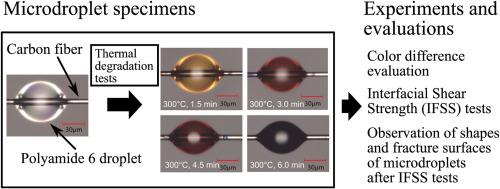Rapid thermal degradation of polyamide 6 microdroplets and its effect on interfacial shear strength to simulate thermal welding conditions of CFRTP
IF 9.8
1区 材料科学
Q1 MATERIALS SCIENCE, COMPOSITES
引用次数: 0
Abstract
The objective of this study is to investigate the effect of rapid thermal processes on the interfacial strength of carbon fiber-reinforced polyamide 6 (PA6) and to elucidate the influence of such processes. To this end, high-speed thermal degradation tests were performed on microdroplet specimens. Initially, the thermal stability of PA6 in a simulated air environment was examined using isothermal gravimetric analysis to determine suitable thermal degradation test conditions. Then, the oxidation of the microdroplets after thermal degradation was assessed by measuring the total color difference between untreated and thermally treated specimens. Additionally, the effects of temperature and the test duration on the interfacial shear strength (IFSS) of the microdroplet specimens were investigated. Even short-term degradation tests decreased the IFSS of relatively small microdroplets, and the size of the microdroplets significantly influenced the IFSS of the resin–fiber interface. Additionally, thermal degradation at the contact area between the microdroplet and the knife edge influenced the test results. At 300 °C, the decrease in the IFSS resulting from thermal degradation was relatively small. However, at 325 °C, a longer duration of thermal exposure significantly decreased the IFSS. For specimens with an embedment length of at least 60 μm, differences in the IFSS were small when the total color difference was small, regardless of the test temperature.

聚酰胺6微滴快速热降解及其对界面剪切强度的影响,模拟CFRTP热焊接条件
本研究的目的是研究快速热过程对碳纤维增强聚酰胺6 (PA6)界面强度的影响,并阐明这些过程的影响。为此,对微滴试样进行了高速热降解试验。首先,采用等温重量分析法考察了PA6在模拟空气环境中的热稳定性,以确定合适的热降解试验条件。然后,通过测量未处理和热处理样品的总色差来评估热降解后微滴的氧化情况。此外,还研究了温度和试验时间对微液滴试样界面抗剪强度的影响。即使是短期的降解试验也会降低相对较小的微滴的IFSS,并且微滴的大小显著影响树脂-纤维界面的IFSS。此外,微液滴与刀口接触区域的热降解也影响了测试结果。在300°C时,由于热降解导致的IFSS下降相对较小。然而,在325°C时,较长的热暴露时间显著降低了IFSS。对于埋置长度在60 μm以上的试样,无论测试温度如何,当总色差较小时,IFSS的差异较小。
本文章由计算机程序翻译,如有差异,请以英文原文为准。
求助全文
约1分钟内获得全文
求助全文
来源期刊

Composites Science and Technology
工程技术-材料科学:复合
CiteScore
16.20
自引率
9.90%
发文量
611
审稿时长
33 days
期刊介绍:
Composites Science and Technology publishes refereed original articles on the fundamental and applied science of engineering composites. The focus of this journal is on polymeric matrix composites with reinforcements/fillers ranging from nano- to macro-scale. CSTE encourages manuscripts reporting unique, innovative contributions to the physics, chemistry, materials science and applied mechanics aspects of advanced composites.
Besides traditional fiber reinforced composites, novel composites with significant potential for engineering applications are encouraged.
 求助内容:
求助内容: 应助结果提醒方式:
应助结果提醒方式:


